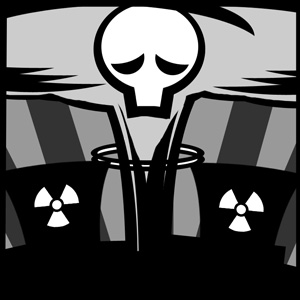Artwork: Nathan Bebb(http://skeptoid.com/episodes/4092)
Let's have a seat at Homer Simpson's control panel, chow down on some donuts, and nap away into oblivion while blinking lights and buzzers warn of impending doom and that glowing green bar of uranium that fell into our trousers. Today we're going to examine the popular notions about nuclear power. Specifically, if xenophobia had not killed nuclear power in the United States in the late 1970's, there's a good chance that we'd have all been driving electric cars for the past 20 years; and uncounted billions of tons of carbon dioxide would never been sucked out of the ground, burned in power plants, and exhausted into our atmosphere.
So let's state the obvious. The immediate reaction to that statement is "OK, that may be true, but look at all the new problems we'd have created with Chernobyl-type disasters and lethal nuclear waste." Fair enough, and important questions, to be sure. Let's start with a quick primer on the various types of nuclear reactors.
So-called Generation I reactors were the early prototypes developed by many nations, and actually placed into production in a few cases. Generation I reactors were characterized by fundamentally unsafe designs, and kludged layers of afterthought safety systems. When most nuclear nations began deploying commercial reactors, they were usually of Generation II design. Generation II reactors were significantly improved, but these changes were primarily evolutionary. Most of the commercial plants in operation in the United States are Generation II designs. A little over ten years ago, Generation III designs began appearing in some of the world's most advanced nuclear nations. Generation III reactors incorporate not only evolutionary improvements, but also revolutionary changes such as fuel cycles that result in much less nuclear waste; reduced capacity for the creation of weapons-grade plutonium; and passive safety designs wherein the reaction cannot be sustained in the event of a problem and the system effectively shuts itself down, by virtue of its basic design. The newest plants being designed for commercial use are called Generation III+, which incorporate all the newest knowledge from operating Generation III designs. If a new reactor was approved and built in the United States today, it would be a Generation III+ design. Even if every plant employee keeled over with a heart attack, neither a Chernobyl nor a Three Mile Island type accident would be possible; the systems are fundamentally redesigned so that the reaction cannot be sustained if things go outside the parameters.
The Idaho National Laboratory is the United States' primary advanced reactor research facility, and they've outlined six new reactor types to be developed for Generation IV. The designs take everything to a new level: Lower cost, safer designs, near-total elimination of nuclear waste, and reduced risk of nuclear weapons proliferation. There are also Generation V reactors in the ether, but these are primarily the domain of late-night rumination sessions at the lab, fueled by tequila and pot.
Then there's fusion power, which is everyone's ultimate goal. Fusion reactors have the profound advantages of using simple tritium or deuterium for fuel, producing no significant waste, and absolute safety since if anything goes even slightly off-kilter, the plasma disappears and you have no reaction. It's the ultimate in cheap, clean, safe, renewable energy, despite gross misunderstandings of the technology expressed by Greenpeace and other factions. The first operational tokamak fusion reactor for research is being built by the international ITER consortium in France and is expected to come online in 2016.
So you can probably guess that Three Mile Island was probably not the newest and safest design, and you'd be right. It was a Generation II design. It was the first and only significant nuclear accident in American history. A broken valve caused coolant to leak into a containment facility designed for that purpose, raising the temperature of the core and causing a partial meltdown. Despite significant confusion on the part of the operators (this being their first experience with an accident), and a somewhat lengthy chain of errors and misunderstandings, everything eventually worked out just as it should. There were no deaths or injuries, and despite 25,000 people living within five miles of the plant, nobody was exposed to any radiation worse than a single chest x-ray. All the studies predict zero cases of future cancer, despite ongoing lawsuits that the courts continue to find to be without merit. With proper perspective, Three Mile Island can (and should) be characterized as a shining example of how well the safety systems work, even in the face of human error and old-fashioned reactor design.
But that's not the way it was perceived. By an unfortunate coincidence, Jane Fonda's movie The China Syndrome about a nuclear accident came out only twelve days before Three Mile Island. The Cold War with Brezhnev was in full force and the words "nuclear accident" were simply too much for a scientifically uninformed public. Three Mile Island became the first nail in the coffin of American nuclear power.
Seven years later in 1986, things got much worse. Chernobyl was suffering from inadequate funding. Much basic maintenance had never been performed. It had only a skeleton crew, nearly all of whom were untrained workers from the local coal mine. The only manager with nuclear plant experience had been a worker installing small reactors on board Soviet submarines. Some genius decided to run a risky test of a type that no experienced nuclear engineer would ever gamble on. The test was to shut down the water pumps, which must run constantly in that type of reactor; and then find out whether the turbines, spinning on their momentum alone, had enough energy to restart and run the pumps during the forty-second delay before the backup diesel generators would kick in. The test was so risky that one faction within the plant deliberately disconnected some backup systems, trying to make the test too dangerous to attempt. The test was run anyway. It didn't work, the pumps couldn't keep up, the graphite core caught fire, the coal miners couldn't find any shovels so they didn't know what to do, and the reactor exploded. If you think I'm exaggerating this, there are extensive resources both online and in print, if you really want the hairy truth. In this short space I'm probably not even giving you ten percent of what a travesty this was — I'm tempted to call it a joke but it's so not funny. For example, they scheduled this right in the middle of a shift change, and the new workers coming in didn't even know what was going on.
Two people died that day, and some 30 to 60 people were dead within three months. Predictions of eventual cancer deaths caused by the radiation run from 1,000 to 4,000. And, of course, the damage to the local environment is extensive and difficult to estimate. The terror of a radiation cloud blowing across Europe was the second nail in the coffin of American nuclear power.
Not only was Chernobyl a monumental failure of the human element, the plant was a Generation I design, specifically an RBMK reactor, which is generally regarded as the least safe reactor type ever built. One design flaw is that the core used combustible graphite, and this distinction is the main reason that Chernobyl-type disasters are not possible in most reactors around the world. Only a very few Generation I designs are still in use, all in the former Soviet Union, and all have been retrofitted with improvements intended to prevent this type of accident. Other nations have long been lobbying for the closure of these reactors, and rightfully so.
How do the dangers of nuclear energy compare to the dangers of fossil fuel energy? A report in the Journal of the American Medical Association found that some 50,000-100,000 Americans die each year from lung cancer caused by particulate air pollution, the biggest cause of which is coal-burning power plants in the midwest and east. Even taking the maximum predicted death toll from Chernobyl, we would need a Chernobyl-sized accident every three weeks to make nuclear power as deadly as coal and oil already is. Shall I repeat that? If the world was filled with Generation I reactors run by feuding coal miners, we would need a worst-case scenario every three weeks just to match the US death toll we've imposed upon ourselves by clinging to our current fossil fuel system. Next time you see a hippie cheering the defeat of nuclear power in the US, realize that a healthy environment and saving lives are clearly not their priorities.
Well, maybe to them it's more about the future of the planet than about saving lives today. Maybe they just don't want to see high-level nuclear waste created that's going to poison the planet for tens of thousands of years. I can see that. But here's the problem with that logic: The plants we're designing now produce less waste than ever. Some on the drawing board produce none at all. We've already created most of the waste that we ever will. It already exists. It's out there. Lobbying against future cleaner plants won't make the existing waste go away. It's out there now in temporary facilities in neighborhoods all across the country, way more vulnerable than it would be in proper permanent storage in Yucca Mountain.
Opponents say that Yucca Mountain is geologically unstable or otherwise too hazardous, so the waste might leak out. Well, trust me: The location of the Yucca Mountain site was one of the most lengthy and expensive decisions the government ever made. What do you think they were doing with all that time and money, picking their noses? Well, it was a government program, so a large part of the time and budget probably was spent on nose mining. Nevertheless, this was one of the most scrutinized decisions ever made. Environmentally speaking it's as good a site as we could hope for. If you're concerned about it, go to a neutral and reliable source and research it personally. From every scrap of reason I can muster, environmentalists should be Yucca Mountain's #1 fans. I can't imagine why they prefer to leave the waste out where it is now, unless they are driven more by ideology than by science. Who would have thought that?
There is a safe and clean solution to our energy crisis, gasoline prices, and global warming. It's the latest generation nuclear reactor.
You should follow me on twitter here.
Thursday, August 13, 2009
The Terror of Nuclear Power
Subscribe to:
Post Comments (Atom)



No comments:
Post a Comment